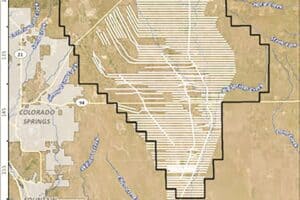More thoughts on metro districts
By Terry Stokka
A few months ago, I wrote an article about the purposes and functions of a metropolitan district in residential development. Just to review, a metro district is a way for a developer to sell bonds to pay for the infrastructure in a development, such as roads and utilities instead of having to borrow money and live with that debt as the lots are sold. Title 32 of Colorado law governs the functions of metro districts.
I believe it is unfortunate that many new homeowners don’t realize the amount of their metro district taxes until they close on their house or lot. Even then, it is a blur with all the signatures and forms that bombard them at closing. To put this in perspective, the property tax rate in El Paso County is around 85 mils, with the variations being the taxes on different school districts and fire departments. Without a metro district, that 85 mils is the total property tax for each property. A metro district can add as much as 65 mils to that to pay back the bonds, so the total property tax bill could be almost double that of a regular property.
A specific example is the proposed Flying Horse North development in Black Forest. The developer is asking the county commissioners to approve a metro district plan to raise $450 million to pay for roads, utilities, a central water system and a wastewater system. In addition to these essential infrastructure items, the metro district proposes to pay for a fitness center and community convention center that is available to the public. My logic says that everyone should pay for the roads, utilities and water systems, but a fitness center and community convention center are optional facilities that not everyone chooses to use so they should not have to pay for it.
The Title 32 law says that metro district bonds can be used to pay for “public” facilities. One of the line items in the Flying Horse North metro district proposal is $39 million for landscaping. My mind has a hard time imagining that much money being spent on landscaping. By contrast, the golf clubhouse is on a private golf course so metro district funds cannot be used for that.
The industry average for metro districts, according to the Colorado Association of Homebuilders, is $30,000 to $40,000 per lot, which works out to $25 to $35 million total for the 900 lots in Flying Horse North. That is a far cry from the $450 million requested.
The developer’s representative presented a slide to the planning commission showing that a $3 million house would pay $1,162 per month or $13,944 per year for metro district taxes. Maybe if you can afford a $3 million house, those taxes aren’t daunting, but to me they are terrible. Add property taxes to that and the estimate would be $2,673 per month of total taxes for that $3 million new house in Flying Horse North.
In my last article, I urged you to get involved in your metro district. Find out when the meetings will be held and get knowledgeable on the issues. Run for an open seat so the residents are more represented. Because metro districts are sort of in the background, they tend to continue being run by the developer and their employees. The residents of Flying Horse on Highway 83 were alarmed when they realized the metro district was $58 million in debt. They rose up and voted to put two more residents on the metro board. A debt of $58 million for 1,599 homes works out to $36,273 per home to pay back, plus interest. Compare that to Flying Horse North, with $450 million in debt for 900 lots. That works out to $500,000 per lot to be paid back over 40 years or $12,500 per year plus interest.
Another metro board in Black Forest, composed of developers, added $6 million to the district debt just before they turned over the board to residents.
All this goes to say that metro districts are a silent group that impacts many residents a great deal; and, if you are in one, you should get educated and active so you as a resident can make decisions that are best for all the residents; decisions that don’t weigh them down with more debt.
The industry average for metro districts, according to the Colorado Association of Homebuilders, is $30,000 to $40,000 per lot, which works out to $25 to $35 million total for the 900 lots in Flying Horse North. That is a far cry from the $450 million requested.






